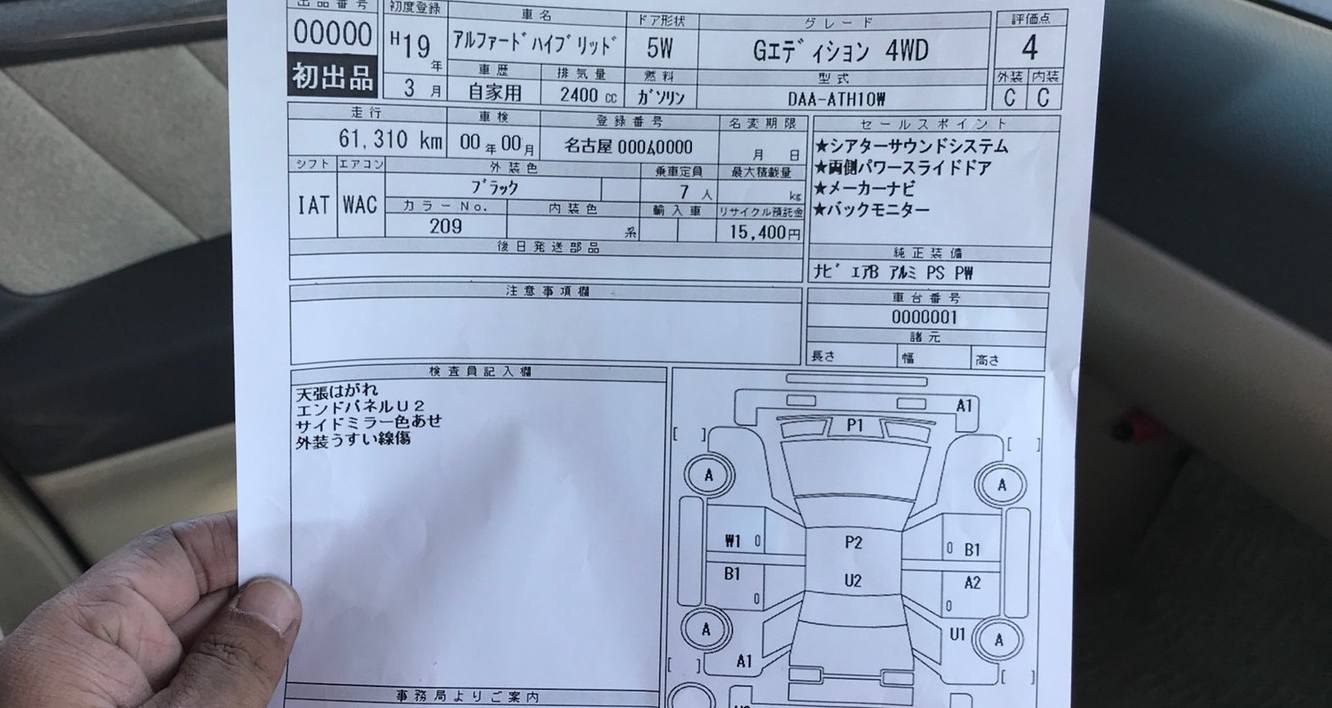So, you have your sights set on a vehicle through a Japanese car auction, but those auction sheets can seem like cryptic hieroglyphics, right? Fear not! Understanding how to read a Japanese car auction sheet is like learning a new language, one that speaks volumes about the car's history and condition. As experts in these auctions, we have compiled a guide to help you decode auction sheets.
What Are Japanese Car Auction Sheets?
In Japan, cars are auctioned off with detailed reports known as auction sheets. These sheets are a treasure trove of information, providing an exhaustive rundown on the car's exterior, interior, and mechanical condition. It's a concise summary that helps buyers make informed decisions without physically inspecting the vehicleCracking the Code: Key Elements to Look for
Japanese auction grades play a pivotal role in understanding a vehicle's condition. Each grade reflects the overall quality, helping buyers gauge what to expect. Here's a breakdown of these grades:- S - New Condition. This represents a nearly vehicle with no visible flaws. The vehicle must have under 100kms and be in showroom status.
- 6 - Like-new condition. Falling slightly below 'S,' this grade still suggests an excellent, like-new, condition. There is not much difference between this and the 'S' grade, often it just denotes that the vehicle has more than 100kms.
- 5 - Very good. A '5' grade vehicle might have some minor imperfections but is well-maintained. For most used cars, this is the highest grade you will see, and somewhat rare.
- 4.5 - Above average condition. A grade 4.5 vehicle should have an exterior in great condition, needing not more than a cut and polish to get into showroom shape. If you’re looking for a car that can be bought and shining right after it hits this port, this would be what to look for.
- 4 - Slightly above average condition. Moving down the scale, a 4 grade signifies a decent vehicle with noticeable wear or a few more noticeable flaws. It's still a viable option for those willing to accept slight imperfections for a lower price.
- 3.5 - Average condition. Dings, dents, and scratches are to be expected, there could also be some larger marks around the body. Most 3.5 grade cars will only require minor repairs to get them back into excellent condition.
- 3 - Below average condition. Falling below the average category, a grade 3 vehicle might have very obvious visible wear and damage to the exterior and require some attention such as panel beating or paint. It's advisable for buyers on a budget willing to invest in repairs or refurbishments.
- 2 - Significant damage. This grade signals a vehicle with substantial damage, possibly requiring extensive repairs or refurbishment. It's recommended for those well-versed in car restoration or seeking a bargain with a readiness for significant work.
- RA - Minor repair history. A car that has been fixed and in better condition now
- R - Repair history. A car that has been repaired, possibly significantly, and possibly may still need more repairs
- No Grade - Major issues. Usually in very poor condition or needs serious repairs, often not running.
Exterior Marks
All auction sheets have a diagram of the vehicle's exterior, with markings to denote specific imperfections on the vehicle. Below are some of the most common marks found on Japanese auto auction sheets.- A - Scratch. Denotes scratches on the car's exterior. These can range from minor surface scratches to deeper ones. It's essential to note the severity and extent of these scratches as they impact the car's aesthetics. . A1, A2, and A3 are used on the exterior to denote the size and severity of scratches.
- W - Paint wave. Indicates repainted areas on the vehicle. While a fresh coat of paint might seem harmless, it's crucial to know why the repainting occurred. Sometimes, it's for cosmetic reasons, but it could also be due to repairs post-accident or corrosion. . W1, W2, and W3 are used on the exterior to denote the size and severity of scratches. Understanding the reason behind the repaint is vital for assessing the car's history.
- B - Dent. Refers to dents on the exterior. This isn't always the typical small dent, but could also be anything more sever than a scratch These imperfections might not significantly affect the car's overall appearance but should be inspected closely for their extent and depth. . B1, B2, and B3 are used on the exterior to denote the size and severity of scratches.
- C - Corrosion. Represents corrosion on the car's exterior. This code indicates rust, which can potentially lead to structural issues if not addressed promptly. It's crucial to assess the severity and extent of the corrosion.
- X - Repaired/replaced. Denotes significant damage or repairs to the exterior. It could include severe dents, major structural damage, or extensive repair work. This code raises significant concerns about the car's condition and history.
Other Abbreviations
Throughout the auction sheet, there are shorthand abbreviations for vehicle details to make the sheets quickly markable for inspectors. The following abbreviations appear on auction sheets frequently.Transmissions
- MT - Manual Transmission
- F4 - Floor mounted 4-speed manual
- F5 - Floor mounted 5-speed manual
- C4 - Column mounted 4-speed manual
- C5 - Column mounted 5-speed manual
- AT - Automatic transmission
- FAT - Floor mounted automatic transmission
Fuel Type (sometimes listed in Japanese)
- G - Gasoline
- D - Diesel
Equipment (Usually circled or listed on the sheet if the car has it)
- AAC - Air Conditioning
- AC - Air Conditioning
- SR - Sunroof
- AW - Alloy wheels
- PS - Power Steering
- PW - Power Windows
- TV - Television
- SRS - Airbag
- AB - Airbag
- ETC - Electronic toll reader (Japan only feature)

